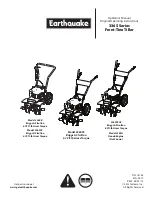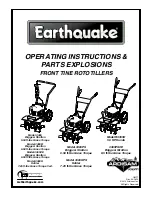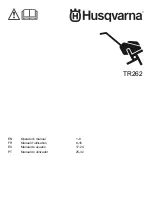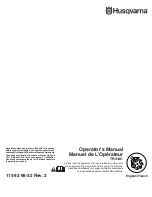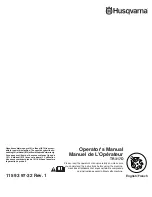
4
LOCK OPEN AND TAG electrical circuits during servicing.
IF WORK IS INTERRUPTED, check that all circuits are de-
energized before resuming work.
DO NOT siphon refrigerant.
AVOID SPILLING liquid refrigerant on skin or getting it into
the eyes. USE SAFETY GOGGLES. Wash any spills from the
skin with soap and water. If liquid refrigerant enters the eyes,
IMMEDIATELY FLUSH EYES with water and consult a
physician.
NEVER APPLY an open flame or live steam to refrigerant
container. Dangerous overpressure can result. If it is
necessary to heat refrigerant, use only warm water.
DO NOT REUSE disposable (non-returnable) cylinders or
attempt to refill them. It is DANGEROUS AND ILLEGAL.
When cylinders are emptied, evacuate remaining gas pres-
sure, loosen the collar and unscrew and discard the valve
stem. DO NOT INCINERATE.
CHECK THE REFRIGERANT TYPE before adding
refrigerant to the machine. The introduction of the wrong
refrigerant can cause damage or malfunction to this ma-
chine.
DO NOT ATTEMPT TO REMOVE fittings, components, etc.,
while machine is under pressure or while machine is
running. Be sure pressure is at 0 kPa before breaking
refrigerant connection.
CAREFULLY INSPECT all relief devices, AT LEAST ONCE
A YEAR. If machine operates in a corrosive atmosphere,
inspect the devices at more frequent intervals.
DO NOT ATTEMPT TO REPAIR OR RECONDITION any
relief device when corrosion or build-up of foreign material
(rust, dirt, scale, etc.) is found within the valve body or
mechanism. Replace the device.
DO NOT install relief devices in series or backwards.
CAUTION
DO NOT STEP on refrigerant lines. Broken lines can whip
about and release refrigerant, causing personal injury.
DO NOT climb over a machine. Use platform, or staging.
USE MECHANICAL EQUIPMENT (crane, hoist, etc.) to lift
or move heavy components. Even if components are light, use
mechanical equipment when there is a risk of slipping or
losing your balance.
BE AWARE that certain automatic start arrangements CAN
ENGAGE TOWER FAN, OR PUMPS. Open the disconnect
ahead of the tower fans, or pumps.
USE only repair or replacement parts that meet the code
requirements of the original equipment.
DO NOT VENT OR DRAIN water boxes containing
industrial brines, without the permission of a competent body.
DO NOT LOOSEN water box bolts until the water box has
been completely drained.
DO NOT LOOSEN a packing gland nut before checking that
the nut has a positive thread engagement.
PERIODICALLY INSPECT all valves, fittings, and piping
for corrosion, rust, leaks, or damage.
PROVIDE A DRAIN connection in the vent line near each
pressure relief device to prevent a build-up of condensate or
rain water.
1 - INTRODUCTION
Prior to initial start-up of the 30HXC and 30GX unit, those
involved in the start-up, operation, and maintenance should be
thoroughly familiar with these instructions and other necessary
job data. This book provides an overview so that you may
become familiar with the control system before performing
start-up procedures. Procedures in this manual are arranged in
the sequence required for proper machine start-up and
operation.
2 - SAFETY CONSIDERATIONS
30HXC and 30GX liquid chillers are designed to provide safe
and reliable service when operated within design specifica-
tions. When operating this equipment, use good judgment and
safety precautions to avoid damage to equipment and property
or injury to personnel.
Be sure you understand and follow the procedures and safety
precautions contained in the machine instructions as well as
those listed in this guide.
DANGER
DO NOT VENT refrigerant relief valves within a building.
Outlet from relief valve must be vented outdoors. The accu-
mulation of refrigerant in an enclosed space can displace
oxygen and cause asphyxiation or explosions.
PROVIDE adequate ventilation, especially for enclosed and
low overhead spaces. Inhalation of high concentrations of
vapor is harmful and may cause heart irregularities,
unconsciousness, or death. Vapor is heavier than air and
reduces the amount of oxygen available for breathing.
Product causes eye and skin irritation. Decomposition
products are hazardous.
DO NOT USE OXYGEN to purge lines or to pressurize a
machine for any purpose. Oxygen gas reacts violently with
oil, grease, and other common substances.
NEVER EXCEED specified test pressures, VERIFY the
allowable test pressure by checking the instruction literature
and the design pressures on the equipment nameplate.
DO NOT USE air for leak testing. Use only refrigerant or dry
nitrogen.
DO NOT VALVE OFF any safety device.
BE SURE that all pressure relief devices are properly
installed before operating any machine.
WARNING
DO NOT WELD OR FLAMECUT any refrigerant line or
vessel until all refrigerant (liquid and vapor) has been
removed from chiller. Traces of vapor should be displaced
with dry air nitrogen and the work area should be well
ventilated. Refrigerant in contact with an open flame
produces toxic gases.
DO NOT work on energized equipment unless you are a
skilled electrician.
DO NOT WORK ON electrical components, including control
panels, switches, relays etc, until you are sure ALL POWER
IS OFF and residual voltage can leak from capacitors or
solid state components.
Содержание 30GX 082-358
Страница 35: ......




















